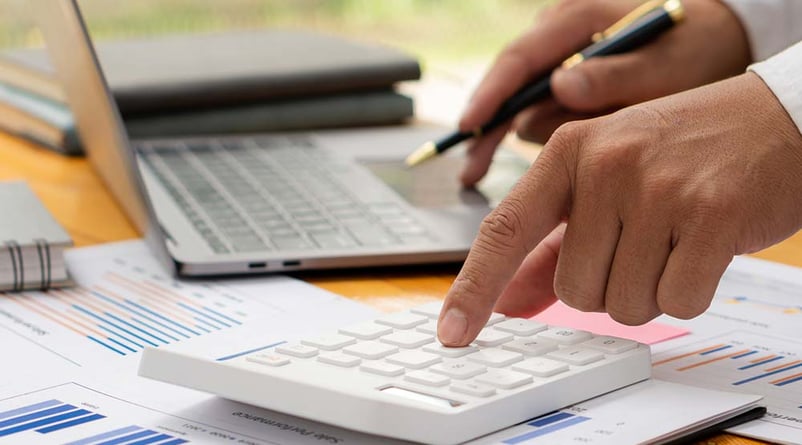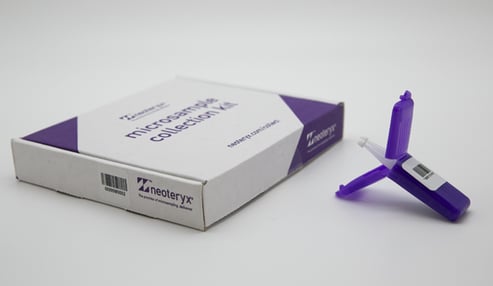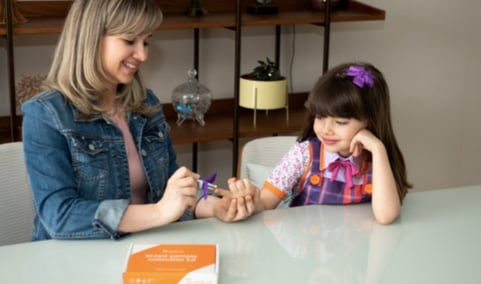Share this
remote therapeutic drug monitoring (TDM): how much money can it save?
by Neoteryx Microsampling on May 8, 2017 5:59:00 AM
Volumetric microsampling technology is the next logical step after conventional dried blood spot (DBS). With volumetric microsampling devices, end-users have a simplified method for drawing blood samples for analysis. The sample collection can be self-administered from any location using a simple finger-stick method.
This remote approach supports remote therapeutic drug monitoring, or TDM. Additionally, the transport and storage of remote dried blood microsamples for TDM is generally simpler and less expensive than working with conventional venous blood samples.
Cost Isn't the Only Advantage of Remote TDM
Another advantage of conducting therapeutic drug monitoring remotely is that it improves the patient experience. A simple finger-prick is far less stressful for many patients who may fear the needles and pain associated with venous blood draws. In many cases, sample collection kits can be shipped out to patients at home, so they can follow the instructions and use the supplies in the kits to collect their own samples.
 Microsampling devices like the Mitra® device based on VAMS® technology, or the hemaPEN® based on capillary and DBS technology, are designed to deliver dried blood samples. The samples dry in the devices during transit to a lab, so there is no need for cold shipping to preserve the viability of the specimens.
Microsampling devices like the Mitra® device based on VAMS® technology, or the hemaPEN® based on capillary and DBS technology, are designed to deliver dried blood samples. The samples dry in the devices during transit to a lab, so there is no need for cold shipping to preserve the viability of the specimens.
The person sampling at home, or assisting with sampling in a remote location, can simply put the sampled device back into its specimen bag, seal that inside the provided pre-paid mailing envelope, and send it back to the lab via standard mail. When the lab receives the samples, they will process and analyze them using a dried blood spot (DBS) workflow.
In some areas of the world, where travel is simply not possible, remote microsampling technology can significantly improve field research studies and access to healthcare.
These benefits come together in one key focus area: therapeutic drug monitoring.
Therapeutic Drug Monitoring & Remote Specimen Collection
For many patients, frequent blood testing is crucial for monitoring their progress on prescribed medications over time. Therapeutic drug monitoring (TDM) is the continued measurement of specific blood levels at defined intervals to ensure a consistent drug level concentration in a person's bloodstream.
 The burden of frequent blood testing (sampling) for TDM is especially difficult when it requires cooperation from children. For example, after children undergo certain procedures, such as renal transplants, their physician must be able to monitor their condition frequently through blood analysis. Frequent blood tests and clinic visits can be stressful for pediatric patients, and burdensome for their families. An at-home sampling approach to routine blood testing can help reduce the burden and stress of follow-up care.
The burden of frequent blood testing (sampling) for TDM is especially difficult when it requires cooperation from children. For example, after children undergo certain procedures, such as renal transplants, their physician must be able to monitor their condition frequently through blood analysis. Frequent blood tests and clinic visits can be stressful for pediatric patients, and burdensome for their families. An at-home sampling approach to routine blood testing can help reduce the burden and stress of follow-up care.
Savings When Using DBS for Therapeutic Drug Monitoring
A December 2016 issue of The Public Library of Science (PLOS), a peer-reviewed international scientific journal, featured a Netherlands cost analysis of the savings potential for using DBS rather than conventional blood testing. The case studies involved recovering children who required TDM. The analysis considered several variables with regard to both patients or family caregivers and labs or medical facilities, such as:
- Travel expenses: transportation, parking
- Loss of productivity: calculation of journey time, plus time spent at the hospital, versus time spent on home sampling and mailing the samples from a nearby mailbox
- Healthcare costs: nurse sampling and supplies versus home sampling and supplies
- Laboratory costs: Comparison of laboratory costs and overhead for clinic-venous samples versus mail-in samples. (Analysis costs were assumed to be similar)
- Doctor’s follow-up/feedback time would be the same in both scenarios
The travel expense portion included a distance factor of 145 minutes round trip and a total time in the hospital of 45 minutes.
Result of the Comparisons: Remote vs. Hospital Sampling
In the study, the remote (at-home) DBS sampling was calculated to be just 39.4% of the total cost of in-hospital sampling. The study showed that the major contributors to the higher costs of hospital-based sampling were:
- The additional costs of travel for the patients
- Lost productivity for the patients or caregivers
- The nurse’s or phlebotomist's time to draw blood samples
If weekly sampling were required over a six-month period, the total expenditure and lost time differentials would mount up substantially.
Remote TDM: DBS vs. Volumetric Microsampling Devices
The Mitra and hemaPEN devices provide the key benefits of working with dried blood samples, but with a volumetrically accurate and stable dried blood spot that reduces the incidence of poor sample quality and/or the need to re-sample.
Volumetric microsampling technologies eliminate many of the practical challenges associated with dried blood spot (DBS):
- Gather a fixed volume (10, 20 or 30 μl), every time
- Eliminate unnecessary sampling steps
- Track samples from end-user to lab with native bar coding
- Use as a sample collection device in remote/at-home Sample Collection Kits
- Reduce costs, travel, and wait times in hospital - just sample and ship!
Find out more about remote microsampling applications for Therapeutic Drug Monitoring by visiting our Therapeutic Drug Monitoring (TDM) Resource Page:


Image Credits: Shutterstock, Trajan, Neoteryx
Share this
- Microsampling (206)
- Research, Remote Research (119)
- Venipuncture Alternative (105)
- Clinical Trials, Clinical Research (83)
- Mitra® Device (73)
- Therapeutic Drug Monitoring, TDM (51)
- Dried Blood Spot, DBS (39)
- Biomonitoring, Health, Wellness (30)
- Infectious Disease, Vaccines, COVID-19 (24)
- Blood Microsampling, Serology (23)
- Omics, Multi-Omics (21)
- Decentralized Clinical Trial (DCT) (20)
- Specimen Collection (18)
- Toxicology, Doping, Drug/Alcohol Monitoring, PEth (17)
- Skin Microsampling, Microbiopsy (14)
- hemaPEN® Device (13)
- Preclinical Research, Animal Studies (12)
- Pharmaceuticals, Drug Development (9)
- Harpera Device (7)
- Industry News, Microsampling News (5)
- Antibodies, MAbs (3)
- Company Press Release, Product Press Release (3)
- Environmental Toxins, Exposures (1)
- July 2025 (1)
- May 2025 (1)
- April 2025 (2)
- December 2024 (2)
- November 2024 (1)
- October 2024 (3)
- September 2024 (1)
- June 2024 (1)
- May 2024 (1)
- April 2024 (4)
- March 2024 (1)
- February 2024 (2)
- January 2024 (4)
- December 2023 (3)
- November 2023 (3)
- October 2023 (3)
- September 2023 (3)
- July 2023 (3)
- June 2023 (2)
- April 2023 (2)
- March 2023 (2)
- February 2023 (2)
- January 2023 (3)
- December 2022 (2)
- November 2022 (3)
- October 2022 (4)
- September 2022 (3)
- August 2022 (5)
- July 2022 (2)
- June 2022 (2)
- May 2022 (4)
- April 2022 (3)
- March 2022 (3)
- February 2022 (4)
- January 2022 (5)
- December 2021 (3)
- November 2021 (5)
- October 2021 (3)
- September 2021 (3)
- August 2021 (4)
- July 2021 (4)
- June 2021 (4)
- May 2021 (4)
- April 2021 (3)
- March 2021 (5)
- February 2021 (4)
- January 2021 (4)
- December 2020 (3)
- November 2020 (5)
- October 2020 (4)
- September 2020 (3)
- August 2020 (3)
- July 2020 (6)
- June 2020 (4)
- May 2020 (4)
- April 2020 (3)
- March 2020 (6)
- February 2020 (3)
- January 2020 (4)
- December 2019 (5)
- November 2019 (4)
- October 2019 (2)
- September 2019 (4)
- August 2019 (4)
- July 2019 (3)
- June 2019 (7)
- May 2019 (6)
- April 2019 (5)
- March 2019 (6)
- February 2019 (5)
- January 2019 (8)
- December 2018 (3)
- November 2018 (4)
- October 2018 (7)
- September 2018 (6)
- August 2018 (5)
- July 2018 (8)
- June 2018 (6)
- May 2018 (5)
- April 2018 (6)
- March 2018 (4)
- February 2018 (6)
- January 2018 (4)
- December 2017 (2)
- November 2017 (3)
- October 2017 (2)
- September 2017 (4)
- August 2017 (2)
- July 2017 (4)
- June 2017 (5)
- May 2017 (6)
- April 2017 (6)
- March 2017 (5)
- February 2017 (4)
- January 2017 (1)
- July 2016 (3)
- May 2016 (1)
- April 2016 (2)

No Comments Yet
Let us know what you think